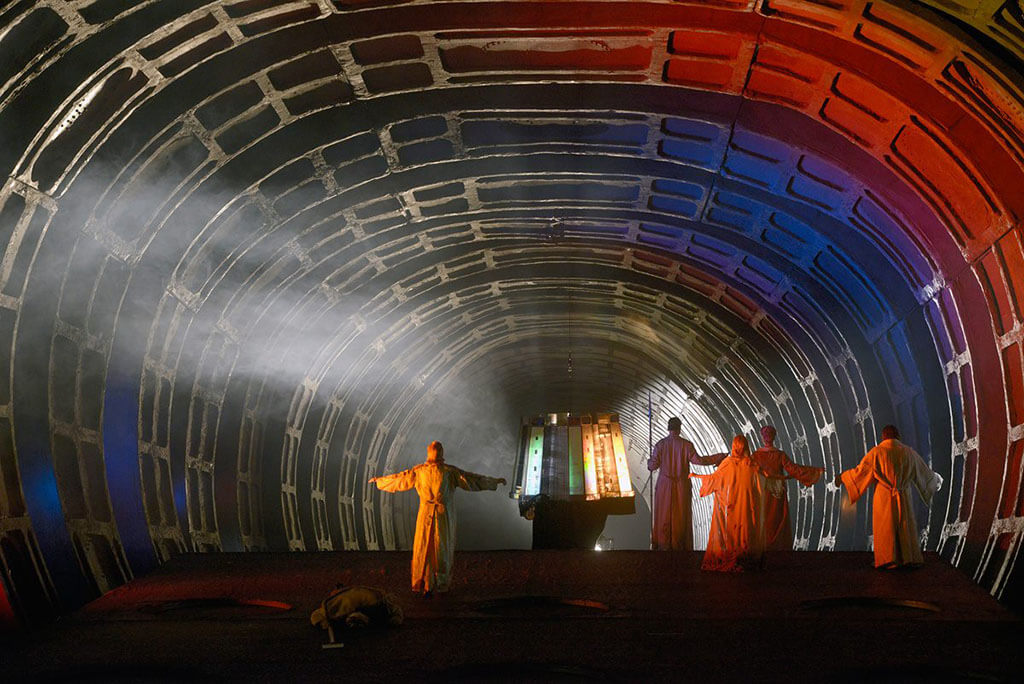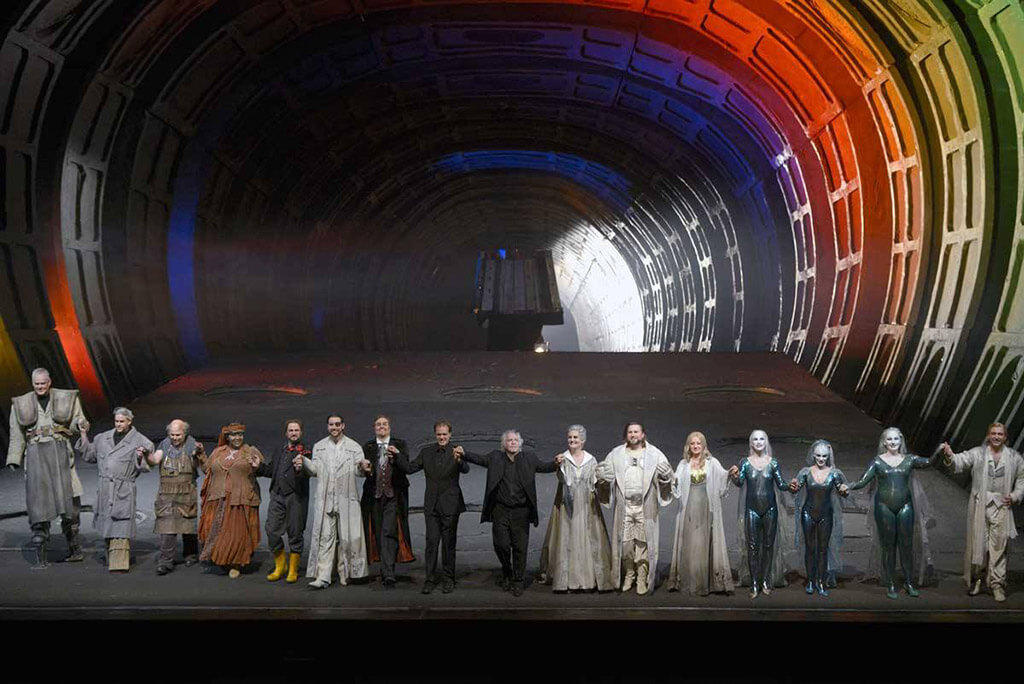
Wagner: Das Rheingold. Derek Welton, Daniela Sindram, Burkhard Ulrich, Werner Van Mechelen, Albert Pesendorfer, Andrew Harris, Martina Welschenbach, Ronnita Miller, Noel Bouley, Attilio Glaser, Paul Kaufmann. Das Orchester der Deutschen Oper Berlin. Apr 13, 2017.
For the inveterate opera traveller, Berlin is a prime destination. Very few cities in the world can boast three world-class opera companies — namely Deutsche Oper Berlin, Staatsoper Unter den Linden, and Komische Oper. And when you add on the legendary Berliner Philharmonie and the equally august Konzerthaus Berlin, one’s cup truly runneth over.
My rather short, current operatic pilgrimage is taking me to two of the three opera houses. It began with the last revival of the Götz Friedrich Ring Cycle at the Deutsche Oper. This production premiered in September 1984 and has been revived many times. It’s an iconic Regieoper approach in its time, and it holds up well, if it is to your taste. The opera house has announced that the new production to come will be directed by Stefan Herheim, another Regie known for pushing the boundaries. Will his Ring be a worthy successor to the late Götz Friedrich?
Two complete cycles are being presented, the first spread over around 10 days. On April 13, I attended the first installment of the second cycle, Das Rheingold. Because the second cycle is presented over five days (with the first three segments given in three days), we have two Wotans. The Rheingold Wotan was Australian bass-baritone Derek Welton, a voice new to me. He is a member of the Deutsche Oper Ensemble. Typical of a Fest artist on the rise, he is extremely busy. A check of his schedule in 2017 reveals fourteen roles, from the comprimario First Nazarene in Salome to major roles like Klingsor and Escamillo.

For Rheingold, he was scheduled for Donner, but with Wotan it is a major step up. I was not disappointed. He sang with big, fresh, healthy, ringing tone from beginning to end. Tall, relatively slim and physically imposing, he was also a dramatically convincing Wotan. Mezzo Daniela Sindram sang Fricka. She is one of the most convincing Komponist and Octavian I’ve ever seen. This is the first time I’ve actually seen her play a woman. She took awhile to warm up vocally, but once she did, she was great. Burkhard Ulrich has the ideal character tenor for Loge, and he acted up a storm; the same can be applied to Paul Kaufmann as Mime.
In fact, the casting of Rheingold fully demonstrates the artistic depth of Deutsche Oper — down to the smallest roles there are no weak links. The bass Albert Pesendorfer, another Ensemble artist, was an excellent Ochs I saw last year. Here he sang the small role of Fasolt impressively. A bit of a giant in real lile, Mr. Pesendorfer hardly needed the elevator shoes assigned to him as a Giant! Erda was the American contralto Ronnita Miller, who has the requisite low register to make Erda’s warning scary enough that any sensible Wotan should have taken pause. But then we would have no Ring, would we…
How about the production? Well, that’s another story. Legend has it that Friedrich’s set was inspired by a postcard of the Washington DC subway sent to him by a friend. Yes, this Ring is underground. The set is dominated by a long tube, cut cross-wise, spanning the width of the stage. Lengthwise, the perspective from the audience is for it to extend into infinity. A small hole here and there would occasionally open up, suggesting a bit of the outside, but over all there’s a serious lack of a sense of naturalism. When Donner strikes his hammer to clear the skies, there is no sky, just a strong light from above shining on him. For Nibelheim, the stage floor rises to review yet another level below of what is already underground. When the gods walk to Valhalla in the final scene, they are more likely walking to the next subway station — okay, I’m saying that with my tongue planted firmly in my cheek.
With the Friedrich production, one pretty much had to ignore any literal interpretation of the text, as well as suspending one’s sense of logic. What we have is the stage director’s vision. Much has been written about this production for the last 33 years and I don’t intend to rehash it. A lack of naturalism is one thing, but the physically enclosed design gives it a sense of claustrophobia, of suffocation, that can be unnerving. Regietheater or no Regietheater, the musical values come first. Here the audience was rewarded in spades. Scottish maestro Donald Runnicles, whose work I’ve admired at the San Francisco Opera, was in great form, conducting with energy and nuance. The Orchester der Deutschen Oper Berlin responded marvellously. The Berlin audience sure loves their maestro! On balance, an auspicious start to the final run of the Friedrich Ring.
Stay tuned for our review of Die Walkure on these digital pages tomorrow.
For more REVIEWS, click HERE.
#LUDWIGVAN
- SCRUTINY | Opera Atelier’s All Is Love Makes Triumphal Return - April 15, 2024
- SCRUTINY | From The Heart: Ema Nikolovska And Charles Richard-Hamelin Offer Unique Program At Koerner Hall - March 26, 2024
- SCRUTINY | The Glenn Gould School Spring Opera Presents A Superb Dialogues Des Carmélites - March 22, 2024



